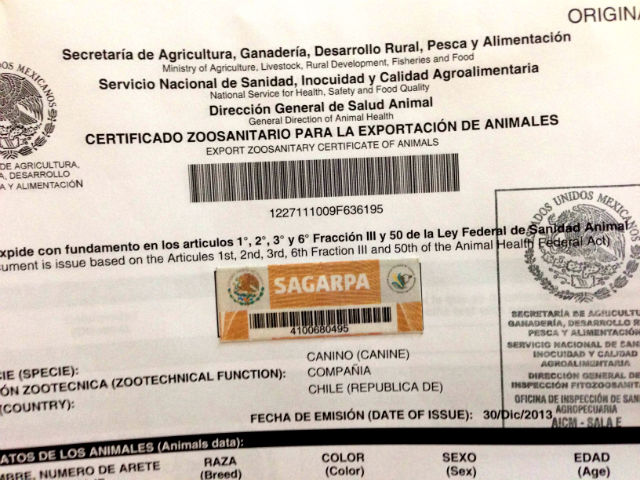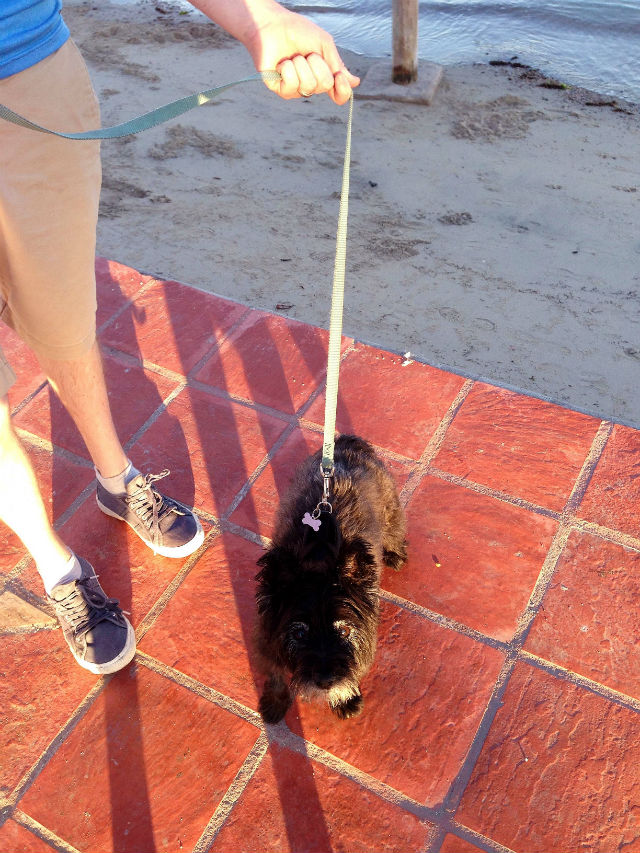30Dec13

Have I mentioned that it’s stressful to bring pets across international borders? Well, it is. Today we got (almost) all the documentation we needed to bring Holly from Mexico to Chile. I say almost because we still have one more step.
For the sake of posterity and any other person who wants to travel with their dog, here’s how to get a pet export certificate or pet health certificate in Mexico. One day I’ll write up how we got one in the U.S. too.
/ BACKGROUND / Any time you are traveling with your pet internationally — versus traveling domestically — there are special requirements. Each country has its own requirements, which may vary based on the country you’re originating from. However, most countries require some kind of official “health certificate” or “export certificate” from a government agency.
/ GETTING STARTED: WHICH AGENCIES WILL I DEAL WITH? / The first thing you should do is determine the name of the government agency you’ll be dealing with in both your country of origin and destination country. It’s usually the equivalent of the USDA, because the whole point of restricting animal importation is to protect a country’s food and livestock from harmful diseases.
- In Mexico, the agency is SAGARPA, which is the Department of Agriculture, Livestock, Rural Development, Fisheries and Food. It has a sub-department that you will deal with primarily called SENASICA, which is the National Agro-Food Health, Safety and Quality Service.
- In Chile, the agency is SAG, which is the Agriculture and Livestock Service.
If you’re having trouble figuring out the agency at your destination, I recommend calling the consulate of your destination country. They may be able to offer you additional guidance, but do not trust consular workers to be up-to-date on pet travel requirements. You should get those directly from the agency. For your country of origin, just ask a local vet.
/ FIND YOUR DESTINATION COUNTRY’S REQUIREMENTS / Once you know the appropriate agency in the destination country, browse their website to find out what they specifically require. Here are the requirements to bring a dog to Chile, as of today:
- A health certificate, in Spanish, issued by the official health authority of the country of origin that is no older than 10 calendar days.
- The certificate must show that the pet:
- Underwent a clinical exam by a veterinarian 10 days prior to shipment and was recognized as free of communicable and parasitic infections
- Was vaccinated against rabies at least one month but less than 12 months prior to shipment (or was tested for rabies antibodies 3-24 months before the trip)
- Received an internal and external antiparasitic treatment within 30 days prior to shipment, including naming the active ingredient, dosage and application date
- The certificate must also include the name of the owner, additional background on any treatments the pet received, and the address where you will stay in Chile.
- There is no cost to import pets.
Be on the lookout for any special requirements for your country of origin. For example, some requirements may be more strict if you’re coming from a country that has different infectious diseases. Or, if you’re coming from a country close by, requirements might be more lax.
Some countries, or smaller airports, may only have inspectors on hand on certain days or during certain hours. Sure, immigration and customs might be open, but there is usually a special inspector who deals specifically with animals. Since we were considering booking a flight to Santiago that arrives at 5:40am, I contacted SAG to make sure they would have inspectors on hand.
/ FIND YOUR ORIGIN COUNTRY’S PROCEDURE / Local vets are a good resource here. They may not know everything, but they can help point you in the right direction. For example, notice how Chile says “health certificate?” Well, the vet here in Mexico told us that SAGARPA/SENASICA call it an “export certificate,” or certificado de exportación.
Unlike in the U.S., run-of-the-mill vets in Mexico don’t have access to official government forms. Rather, vets help you with your documentation, and then you pay a visit to SAGARPA/SENASICA in person with your documents to obtain your certificate. In Mexico City, that means going to the SENASICA public service window at the airport. I called their office to find out what they needed and confirmed that we only needed to bring our paperwork — not the dog. They will need to see the dog eventually though; more on that later.
/ PLAN AHEAD, BUT NOT TOO FAR AHEAD / So, you probably noticed based on Chile’s requirements that you can’t do this on a whim. Same with most countries: you typically have to have most vaccinations complete a minimum of 30 days before you leave. So make sure you get all the vaccinations you need ahead of time. Why? Like in humans, it takes a little while for vaccines to take effect in animals.
However, don’t be too much of an early bird. Some paperwork has a firm expiration date. For example, a health certificate from a vet in Mexico is only good for five calendar days, meaning SAGARPA/SENASICA won’t give you your export certificate if the paperwork from your vet is expired. And the export certificate you obtain from SAGARPA/SENASICA can only be a maximum of 10 days old when you arrive in Chile. So, plan accordingly when scheduling vet visits and going to get your export certificate. Why the last-minute nature? An animal’s health can change quickly and there has to be a set window in which health results are considered valid.
/ TAKE YOUR DOG TO THE VET / When taking your dog to the vet to get their health certificate, DO NOT assume your vet will know a) what you need in order to get your export certificate in your origin country, or b) what your destination country’s requirements are. If you just ask them for a health certificate, they give the dog a brief physical exam and write up something on their letterhead saying the dog is healthy and disease-free, as well as confirm basic characteristics such as age, color, breed, weight, etc. That’s fine, but insufficient.
Instead, bring your destination country’s requirements with you! For example, our vet gave us documentation specifically noting that Holly is free of parasites and that she has received internal and external antiparasitic treatment. We had to go back a second time for the latter, since we thought it would be sufficient to bring the pills with us to SAGARPA/SENASICA. Do not make this mistake. Unless it’s signed by a vet, government agencies won’t accept it. Lastly, we already had documentation from our vet in the U.S. of her rabies and other vaccinations.
Depending on what the vet has to do, you can expect the exam and health certificate to cost approximately 300 pesos.
/ PAY A VISIT TO SAGARPA/SENASICA / Armed with our documentation, we took the metro to the airport. We ended up having to make two trips because we were missing the internal and external antiparasitic treatment documentation I mentioned above. On our second trip, we almost got sent away again because it was the last day our vet’s health certificate was valid and our trip isn’t for another couple days. It took a combination of pleading and assertiveness to get them to understand that, while the health certificate from our vet would be expired in Mexico before our trip, the exportation certificate would still be valid in Mexico and both would be valid in Chile.
Then, there was some difficulty which our vaccination documentation because it was in English and not on a “carnet de salud,” or health card, which is what vets traditionally provide in Mexico. Basically, it’s a booklet with a pet’s vaccination and health records all in one place. Our documentation was in the form of an invoice from our vet, which listed the vaccinations received, the dates, Holly’s patient information, the cost, and included the vet’s signature.
But the man told me that the information needed to be in a carnet de salud and that he could not accept this, even though it specifically said Holly got a rabies vaccination on September 7. I pointed this out to him and he told me that it didn’t have the signature of the vet who gave us our health certificate. I pointed to the signature from the vet in the U.S. who gave the vaccination. He finally acquiesced. Remember, bureaucracies are the same all around the world. Be patient and assertive.
We handed over copies of all of our documentation and walked away with our export certificate. We celebrated with coffee and Cinnabon at the airport. We just have to bring Holly in person before our flight — so we have to arrive even earlier — for a final check and another signature on the certificate before we can leave.
The flyer on the wall said that export certificates cost 421 pesos, but we were not charged anything. However, it’s possible we’ll have to pay that when we come back for the second signature.
/ OTHER TIPS / Here are a few additional tips:
- It really helps to know some Spanish. My Spanish has improved wildly since being in Mexico, and I was able to have fairly complex conversations with both vets and government officials, in person and by phone. If your Spanish isn’t that good, make sure to ask people to speak slowly and repeat back what you think you heard them say to make sure there are no miscommunications.
- Make copies. Make two or three copies of all your documentation, and never give away your originals. Do not expect government agencies to make copies for you — they will send you somewhere where you can pay to make them yourself.
- Don’t assume. It’s up to you to know what the requirements are and make sure you have what you need. Ask lots of questions. Tell people exactly what you’re going to do and ask them if they see any problems; don’t expect them to offer the information proactively.
- Check your airline’s requirements too. Chances are, if you’re meeting your destination country’s requirements, you’ll be fine with your airline. But check with them too in case they have any special requirements before allowing you and your pet to board.
- Be your own advocate. If you’re not getting what you need, show documentation and ask again. If you’re not confident you’re getting the right information, get a second opinion. You have to be assertive!
Oh, the things we do for this girl. We love you, Holly.



